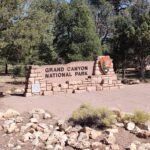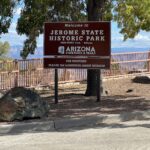Imagine yourself many years ago, traveling Route 66 through the Navajo and Apache Counties of Arizona. A dry desert landscape, with some of the most stunning views in Arizona. If you enter from the east, through your car window you will see a colorful badlands landscape of high cliffs and steep mesa tops. Layers of sedimentary rock in beautiful bands of reds, whites, light blues, and greys wrap around the cliff sides. The longer you look at the earth before you, the more colors and formations you can pick out. Driving from the west, you enter the area and begin seeing high rolling hills in the rocky terrain. Whole logs, and parts of logs that appear to have been sawn intentionally, litter the land. As you get closer, you realize it isn’t wood, but rocks that appear to be wood. In fact, they once were wood in the form of ancient trees from over 225 million years ago during the late Triassic Epoch. Each having gone through a miraculous replacement of wood to stone from a rare process called “Petrification.”
The Petrified Forest History

Mentioned previously, the Petrified Forest is located on the western side of the Petrified Forest National Park. For the average person, it sort of makes sense that when something sits for millions of years, it turns hard and then eventually turns to stone. However, that isn’t how the process of petrification works. Petrified wood hasn’t actually been “Turned” to stone. In reality, the organic material of the wood has been replaced by a material that becomes stone. The process is what gives us fossils, such as dinosaur bones, fossilized animals, and ancient leaves. While it’s not that far of a stretch to imagine a hard substance like bone to become stone, it’s almost unimaginable how something like a leaf or wood can withstand the millions of years it takes for the process to complete. It’s hard to imagine, when looking across the vastness of the area, that it was all under water once. It really hits home when you realize that all of the fossilized trees you see were once floating around and could be far from their original location. Once buried deep into the earth below, now with each passing year, more of these petrified wood portions are uncovered by erosion.
Petrification happens when organic material is replaced by either minerals or silica. When the material is buried in earth or submerged in water, a replacement of the original tissue can begin. When in water, high amounts of silica, dropped by volcanic ash, begin to replace the organic material at a cellular level. This process is called Silicification. As the material is replaced by silica, the silica takes the shape of the organic material and then hardens into a crystalline form, resembling the original substance. For example, an entire tree can be replaced by the silica if it remains submerged in sediment and water, leaving behind a “stone” or crystal version of the tree. It can be such a close clone of the original, that the rings of the original tree, some of the colors, and even the bark can look real. After the process is complete, beautiful crystals, of varying colors can be hidden in the leftover structure.
Pyritization is another type of petrification. Pyritization happens when an organic substance is exposed to iron in the buried sediment and water. Sulfides in the original material react with the iron to form pyrite, or “Fools gold.” An organic material can then be replaced by pyrite, silica, calcite, or even hematite. Leaving behind a very detailed stone “fossil” of the original. Archeologists uncover these items in sometimes great detail and often in complete restructure of the original. We can think of this example when we break open a piece of ancient rock and find a perfectly preserved leaf in the center.
The Painted Desert

On the eastern side of the Petrified Forest National Park lies the Painted Desert. Across the “desert’, you see layers of siltstone, mudstone, and shale, colored by the presence of volcanic ash, iron and manganese. Erosion of all of these soft materials has formed the landscape into badlands, exposing the beautifully colored layers in a moonlike, jagged terrain. Each layer you see tells a story dating back to the Triassic period, millions of years before.
While the individual layers tell a story, remarkably, there are missing layers that also tell a tale of their own. To understand what happened here, let’s use the pages of a book and stack each page on a table, starting with page 1 at the bottom. Ten pages, then twenty, then two hundred, and so on. Then, lets now remove the last forty pages and then continue stacking, but keep our original count. When we complete the book, the pages are all in order, except the missing forty pages in the center, right? To put it all in context with the Painted Desert, layer 1 is on the bottom, then ten layers and so on. Except, somewhere after a couple hundred layers, a long period of erosion happened, and wiped out forty layers. Then more sediment was piled on top, from volcanoes and such. See how it’s similar to our book analogy? In the painted desert, we see layers of sediment in order, except in the middle where some layers are missing. Scientists believe these missing layers were once more than one thousand feet thick. The gap in layers is called an “unconformity.” The gap itself tells the story of erosion by moving water. A time when the area was covered in a vast river of flowing water that washed away hundreds of feet of sediment.
Once you understand that volcanoes are present in the area, you can see how both the Petrified Forest and The Painted Desert came to be and how they are uniquely different yet formed together. A vast ocean once covered the area, volcanoes spewed their minerals and silica into the air and settling into the water. Layers of sediment formed, and organic material became trapped below. Minerals and silica in the water began to replace the organic material at cellular levels, and as everything became buried, the climate changed, and the land began to dry up. What was left was layer upon layer of sediment and fossils, capped by volcanic ash and rock into what would later become a desert landscape. Wind and water work on the soil and erosion began to expose all of the hidden secrets from below, leaving behind the vastness that we now explore.
An Astonishing Drive Through History
We approached the Petrified Forest from the south on 180. The north entrance to the park is just off I40. The National Park is roughly 26 miles from north to south, and as you drive through the park, there are many pull-offs to stop, take pictures, picnic, or even go hiking. From the ranger station at the south, we used our National Park Pass to enter for free. We also stopped at the visitor center and had our National Park Passport stamped and purchased some souvenirs. There is also a very educational display of fossils inside the visitor center, as well as a place for kids to learn the process of excavating fossils from the ground.

Almost immediately upon entering the park, you begin to see the ground littered with sections of Petrified wood and near complete logs. It’s hard to comprehend how many of these fossilized sections of trees have been unearthed from the erosion over the years and more showing themselves all the time. We pulled off at two separate places, where you could take a paved walk through the desert and see them up close. AT some points, for as far as you could see, the land was just dotted with stumps that were deposited by ancient waters.
As you move through the park, you will notice an almost instant change in landscape. From rolling hills and small precipices to amazing gorges carved in badlands fashion. The layers of history, prominent in more colors than can be described. As the sun changes angle, so does the brilliance in color. Pull-offs provide picturesque views of the beauty that stretches out across the land. Trailheads allow visitors a unique chance to explore the rugged country. At one stop, you can stand where ancient civilizations stood before you and see their messages to us carved on the rock walls. Petroglyphs provide communication back to us. As I looked at them through the provided telescopes provided by the park, I wondered if it were adults that left them to tell us their story. Or was it children playing and leaving their drawings behind. Perhaps it was communication between tribes. Sort of like modern billboards or road signs, maybe they were advertisements to other people, so they could find each other. Regardless, it’s fascinating to think that I was standing in the footsteps of people from many, many years before.

Towards the end of the drive north, you end at an old hotel. The Painted Desert Inn, later Known as the Harvey House, still stands as a reminder of life in the early 1900’s through the 1960s. Travelers of the old Route 66 would have found a meal, a milk shake, and maybe even a place to sleep at the Inn. Though it was set to be demolished at one time, protests led to it being restored as a museum that stands inside the National Park. Even the old menus still stand inside this unique structure.
A Day of Education and Awe
Just outside of the park, a reminder of a more recent time past. The time when Route 66 was the way we made our way across the country, through deserts, mountains, plains, and nearing oceans. A place to stop and see a 1932 Studebaker, parked along the roadside, slowly rusting away, where it will someday disappear into the earth. Perhaps a future culture will find a piece and wonder how it came to this place and why.

We left the Petrified Forest National Park with new knowledge. It’s hard to imagine what “millions” of years truly is. But, if you look at what is left behind, study it, and realize what it takes to create it, you can get a glimpse of the time it took. When you look at a house sized crystalline tree and then realize how it was once wood and replaced by stone. Or you see the layer upon layer of sediment before your eyes, like a mural across the land, you begin to comprehend how our existence is just a tiny spec in time, compared to how long the earth has been here, changing, evolving, reshaping itself, and leaving behind puzzle pieces for us to put back together.

